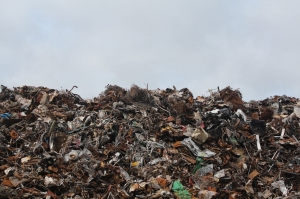The reduction of medical waste has become a significant trend. Microwave sterilizers are creating excitement in this field. Eco-friendliness actively supports this trend. Global environmental awareness is growing exponentially every year. Various sectors actively seek innovative solutions. It allows them to reduce their carbon footprint. The reducing medical waste control sector is no exception. Traditional methods are being increasingly questioned. This questioning stems from their negative ecological impact. Traditional methods lead to air pollution and greenhouse gas emissions. They consume significant land resources. These methods create potential risks of soil and water contamination. These situations are irreversible and have devastating consequences.
Reducing waste in healthcare is more important than many people realize. It's not just about throwing things away, but doing it sustainably. Healthcare professionals must consider the impact each type of waste can have on health and the environment. The amount of waste generated is enormous. Much of it is still not disposed of properly. We will look at how responsible waste management can make a difference. We'll examine what problems and solutions are crucial to make it happen.
The Urgent Need for Reducing Waste in Healthcare
Reducing waste creates a more sustainable and responsible system. Hospitals generate large amounts of trash daily. They dispose of single-use plastics and hazardous materials. Medical centers also accumulate unused supplies. It contributes to environmental pollution and resource depletion. Better waste segregation and inventory management can significantly reduce this burden. Taking action now is essential for long-term health and ecological balance. Below is a numbered list of strategies for reducing medical waste:
- Reusable Medical Devices: Use sterilizable tools instead of disposables. They cut down on single-use waste.
- Waste Segregation Systems: Sort waste into recyclable and hazardous materials. Proper sorting boosts recycling rates.
- Eco-Friendly Supplies: Choose biodegradable or recyclable packaging. They reduce landfill contributions.
- Digital Documentation: Replace paper records with electronic systems. It minimizes paper waste.
- Inventory Management Software: Track supplies and equipment to prevent overstocking. It avoids expiration and waste.
These strategies reduce waste in healthcare and promote sustainability. They lower costs and conserve resources. These modern methods also reduce pollution. Medical facilities must act swiftly to implement these measures. Collaboration among staff, suppliers, and regulators is key. Challenges include initial costs and resistance to change. Long-term benefits outweigh these hurdles. Industry must prioritize reducing waste. It can protect the environment and public health. Facilities should assess current practices and adopt these solutions. These steps help build a greener future.
Eco-Friendly Waste Management: Best Practices for Facilities
Sustainable healthcare depends on implementing eco-friendly waste management practices. They protect the environment while supporting efficient use of resources. Hospitals and medical facilities produce various types of waste. They include hazardous and non-hazardous materials. Facilities must handle this waste responsibly to minimize environmental impact. Medical providers must adopt greener approaches. They can significantly reduce their ecological footprint. Practicing proper segregation and using sustainable products are essential. These efforts also improve compliance and operational efficiency. Below is a numbered list of best practices for eco-friendly waste management:
- Staff Training: Educate employees on waste reduction. Regular training ensures compliance.
- Waste Audits: Conduct regular waste assessments. They identify areas for improvement.
- Energy-Efficient Disposal: Use eco-friendly incinerators for hazardous waste. They lower emissions.
- Donation Programs: Donate unused and unexpired supplies. It reduces waste and supports communities.
These practices advance the medical field through sustainable healthcare. They lower costs, conserve resources, and reduce pollution. Healthcare facilities must adopt these measures. They help to minimize their environmental footprint. Implementation requires investment and staff commitment. Regular monitoring ensures long-term success. Facilities should collaborate with vendors and regulators to align with green standards. Healthcare can protect the environment and public health. This requires prioritizing eco-friendly waste management. Start with small changes, like better segregation. Scale to comprehensive programs for maximum impact.
Sustainable Waste Disposal Methods for Medical Facilities
Reducing waste through sustainable practices is essential. It promotes eco-friendly and responsible healthcare practices. Medical facilities generate waste daily. It includes plastics and infectious biohazards. Without proper handling, this waste can pose serious risks to the environment and public health. Implementing sustainable disposal methods and eco-friendly alternatives is essential. Waste segregation and recycling programs are crucial. They help minimize environmental impact. These strategies support long-term sustainability goals in the medical sector. Below is a numbered list of sustainable waste disposal methods:
- Autoclaving for Biohazards: This process steam sterilizes infectious waste. It reduces hazards before disposal.
- Recycling Non-Hazardous Waste: These materials include plastics, glass, and paper. Partner with certified recyclers.
- Composting Organic Waste: Compost food and non-hazardous organic waste. It diverts waste from landfills.
- Reusable Sharps Containers: Use a sterilizable sharp container. They reduce single-use plastic waste.
These methods support reducing medical waste. They lower the environmental impact and conserve resources. These strategies also reduce costs. Medical facilities must adopt these practices to align with green standards. Implementation requires staff training and infrastructure upgrades. It also demands vendor partnerships. Regular audits help track progress and identify gaps. Challenges include initial costs and regulatory compliance. The long-term benefits are significant. Facilities prioritizing sustainable waste disposal contribute to a healthier planet and community.
How Green Hospitals Are Leading the Change
Environmentally-conscious hospitals lead the way in integrating sustainability into modern healthcare. They adopt eco-conscious practices. These methods benefit patients and the planet. These innovative facilities focus on reducing medical waste and conserving energy. They use non-toxic materials and source sustainable supplies. Green hospitals set a powerful example for the broader medical industry. They prioritize environmental health alongside patient care. Their commitment to sustainability lowers ecological impact. It also fosters healthier healing environments. Below is a numbered list of key initiatives by green hospitals:
- Energy-Efficient Systems: Install LED lighting and smart HVAC systems. They cut energy use significantly.
- Renewable Energy Sources: Use solar or wind power to reduce reliance on fossil fuels.
- Sustainable Building Materials: Use eco-friendly materials in construction. They lower the environmental impact.
- Water Conservation Systems: Install low-flow fixtures and rainwater harvesting to decrease pollution.
- Green Procurement Policies: Source biodegradable or recyclable supplies to support sustainable vendors.
These initiatives showcase how green healthcare advances sustainability. They reduce costs and improve patient health. These initiatives also protect the environment. These facilities set a global standard. They integrate renewable energy and efficient waste systems. Challenges include high initial costs and staff adaptation. Long-term savings and benefits are substantial. Green healthcare practices inspire others by proving that sustainability is achievable. Facilities should start with energy audits and waste segregation. Then scale to renewable energy. Collaboration with policymakers and suppliers enhances impact. Green hospitals lead the charge for a more sustainable future through these efforts.
The Future of Sustainable Healthcare: Trends & Innovations
Sustainable development in healthcare is progressing swiftly. The industry recognizes the urgent need for sustainable practices. Key priorities include lowering emissions and adopting eco-friendly technologies. These technologies are crucial to modern healthcare systems. These forward-thinking approaches support environmental health while improving both cost efficiency and operational effectiveness. Innovations are reshaping care delivery. These innovations include energy-efficient infrastructure, green procurement, and digital health solutions. Below is a numbered list of future-focused strategies crucial for sustainability in healthcare:
- AI Waste Analytics: AI tracks and optimizes streams to identify reduction opportunities.
- Biodegradable Medical Supplies: Use compostable bandages and packaging to minimize landfill waste.
- Circular Supply Chains: Recycle and reuse medical materials to reduce resource consumption.
- Green Energy Adoption: Hospitals use solar and wind power to lower their carbon footprints.
Resource conservation and public health gains are significant benefits. Medical facilities must invest in these trends to stay competitive. Collaboration with tech providers and regulators is crucial. The medical sector can lead in reducing medical waste by embracing these methods. Each of us plays a vital role in this process. We must rethink our consumption habits and learn how to dispose of waste properly. These steps are essential to ensure a sustainable future for generations to come.






